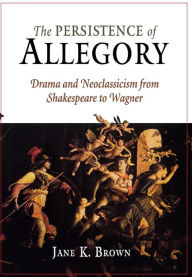Jane K. Brown is Professor of Germanics and Comparative Literature at the University of Washington, Seattle. She is the author and editor of several books in English and German, including Goethe's Faust: The German Tragedy and Ironie und Objektivitat: Aufsatze zu Goethe, and is the former President of the Goethe Society of North America.
The Persistence of Allegory: Drama and Neoclassicism from Shakespeare to Wagner
eBook
-
ISBN-13:
9780812201475
- Publisher: University of Pennsylvania Press, Inc.
- Publication date: 04/23/2013
- Sold by: Barnes & Noble
- Format: eBook
- Pages: 304
- File size: 3 MB
Available on NOOK devices and apps
Want a NOOK? Explore Now
In an impressively comparative work, Jane K. Brown explores the tension in European drama between allegory and neoclassicism from the sixteenth through the nineteenth century. Imitation of nature is generally thought to triumph over religious allegory in the Elizabethan and French classical theater, a shift attributable to the recovery of Aristotle's Poetics in the Renaissance. But if Aristotle's terminology was rapidly assimilated, Brown demonstrates that change in dramatic practice took place only gradually and partially and that allegory was never fully cast off the stage.
The book traces a complex history of neoclassicism in which new allegorical forms flourish and older ones are constantly revitalized. Brown reveals the allegorical survivals in the works of such major figures as Shakespeare, Calderón, Racine, Vondel, Metastasio, Goethe, and Wagner and reads tragedy, comedy, masque, opera, and school drama together rather than as separate developments. Throughout, she draws illuminating parallels to modes of representation in the visual arts.
A work of broad interest to scholars, teachers, and students of theatrical form, The Persistence of Allegory presents a fundamental rethinking of the history of European drama.
Customers Who Bought This Item Also Bought
-
- Goethe's Allegories of…
- by Jane K. Brown
-
- Goethe's Faust and…
- by Lorna Fitzsimmons
-
- Timon of Athens
- by William ShakespeareNicholas Walton
-
- Measure for Measure
- by William ShakespeareNicholas ArnoldJ. M. NosworthyJulia BriggsJulia Briggs
-
- Murder Most Foul: Hamlet…
- by David Bevington
-
- Cymbeline
- by William ShakespeareJohn Pitcher
-
- Shakespeare and the Rose of…
- by John Vyvyan
-
- Faust, Part I
- by GoetheDavid Constantine
-
- Gemstone of Paradise: The Holy…
- by G. Ronald Murphy
-
- Rabindranath Tagore: A…
- by P. GopichandChristophe Brochier
-
- The Yellow House - Master of…
- by E. Phillips (Edward Phillips) Oppenheim
Recently Viewed
"Her approach yields much that is valuable, especially in connection with Shakespeare, Calderon, and the German authors. . . . a healthy reminder of the daunting complexity of the Western tradition of drama."—Comparative Literature Review
"An ambitious survey of a great deal of culture, attempting links and connections on a grand scale."—David Bevington, University of Chicago
"The richness of many of Brown's readings and her remarkable scholarly range fuel her argument and ultimately provide a compelling picture of allegory's afterimages, which appear and recede across the history of Western drama from the sixteenth century."—Modern Philology











